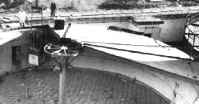Zagrożenie eksplozją składowiska odpadów
 Rosyjskie składowisko odpadów z elektrowni nuklearnych, które znajduje 40 km od granicy z Norwegią w Zatoce Andriejewa przy Półwyspie Kolskim, w każdej chwili grozi ogromnym skażeniem środowiska - ostrzega norweska organizacja Bellona. Składowisko nawet grozi eksplozją.
Rosyjskie składowisko odpadów z elektrowni nuklearnych, które znajduje 40 km od granicy z Norwegią w Zatoce Andriejewa przy Półwyspie Kolskim, w każdej chwili grozi ogromnym skażeniem środowiska - ostrzega norweska organizacja Bellona. Składowisko nawet grozi eksplozją.
Jak doniósł norweski dziennik "Aftenposten", przed groźbą nieobliczalnej w skutkach eksplozji powiadomiła władze Rosji państwowa agencja energii atomowej Rosatom. "Aftenposten" dotarł do raportu, w którym Rosatom ostrzega: "Nikt nie potrafi określić, kiedy może nastąpić wybuch, za kilka godzin, kilka dni czy za rok".
Składowisko w Zatoce Andriejewa kryje obok zużytego paliwa atomowego także fragmenty reaktorów okrętów podwodnych, elementy ich wyposażenia zawierające pierwiastki promieniotwórcze itp.
Działacze Bellony wzywają władze Norwegii, która od wielu lat współfinansowała zabezpieczanie składowiska, aby przy pomocy innych krajów Europy wymusiła na Rosji likwidację zagrożenia.
Informacja o zagrożeniu eksplozją w Zatoce Andriejewa stała się wiadomością numer jeden wszystkich norweskich mediów.
Jak poinformował Norwegów Aleksandr Nikitin, od lat monitorującej m.in. skutki atomowych poczynań na północy Rosji, w najlepszym wypadku eksplozja obejmie jedynie skład prętów uranowych. Może to spowodować skażenie radioaktywne w promieniu 5 km. W najgorszym zaś wypadku wybuchnie całe składowisko. Skutków takiej eksplozji nie potrafimy jeszcze określić.
Two articles in English:
Article from "the Scotsman"
'A ticking nuclear time bomb'
JAMES KIRKUP AND CONOR SWEENEY
SUSPENDED from the ceiling, they are covered in deadly radioactive material that drops off them in lumps to the wet floor beneath. The 20,000 fuel rods contained in three tanks at the Andreeva Bay storage site once held enough nuclear energy to power Russia's entire submarine fleet.
Now, cracks in the concrete walls of the dilapidated tanks have allowed seawater and rainwater to seep in and corrode the lethal contents.
The situation is so bad Russia's nuclear agency has warned rods at the site could explode in an "uncontrolled chain reaction", according to a Norwegian environmental group, which says it has a leaked copy of a report.
Experts say that could set off an explosion scattering radioactive material across northern Europe, reaching even as far as Britain, in an environmental catastrophe worse than the Chernobyl disaster.
"We are sitting on a powder keg with a fuse that is burning, but we don't know how long that fuse is," said Alexander Nikitin, a former Russian navy officer and Bellona environmental activist who first revealed the existence of the dump at Andreeva Bay, on the Kola peninsula of north-western Russia.
The nightmare scenario, identified by Russia's Federal Nuclear Agency, raises new fears that Moscow is failing to properly manage the potentially deadly nuclear legacy of the Cold War, which has left the country with tonnes of plutonium and uranium and millions of tonnes of nuclear waste to deal with.
The report, leaked to the Norwegian group Bellona, centres on Andreeva Bay, only 30 miles from the Norwegian border. "Ongoing degradation is causing fuel to split into small granules. Calculations show that the creation of a homogenous mixture of these particles with water can cause an uncontrolled chain reaction," reads Bellona's translation of the document.
Such a chain reaction would generate enormous heat and potentially release hydrogen from the seawater. That could lead to an explosion, hurling radioactive material into the atmosphere. "The radioactive fallout could be higher and affect northern Europe to a greater degree than the region was hit by the Chernobyl disaster." said Nils Boehmer, the atomic physicist who heads Bellona.
John Large, an independent British nuclear consultant who has visited the site several times, also likened the possible result to the Chernobyl explosion in 1986. "This wouldn't be a thermonuclear or atomic explosion as in a bomb, but the outcome is just as bad," he said.
"Remember Chernobyl? Well if you had the right weather conditions, the right wind pattern, this would mean a radioactive cloud drifting over Scotland and the rest of the UK."
Uranium used in Britain's civil nuclear plants is normally only 3 per cent enriched; Russian military uranium is often enriched at levels between 20 and 40 per cent, making the material at Andreeva Bay especially toxic.
Attempts to clean up Russia's nuclear legacy are complicated by the secrecy of its defence establishment about the sites. The Kola dump is thought to be the largest, with all the nuclear waste from the Russian navy's northern fleet stored there, although Moscow still insists much of the fuel comes from nuclear-powered ice-breakers.
Ben Ayliffe, head of nuclear campaigning at Greenpeace, said the Andreeva Bay dump was "potentially incredibly dangerous - there is huge risk that the balloon could go up there". He also raised security concerns, warning: "It's open house up there - anyone who wants can just walk into the place."
A spokesman for the Russian nuclear agency, known as Rosatom, denied there was any threat to the public from the storage tanks. "The objects are being kept in such a way that there's no danger of an explosion or an uncontrolled chain reaction," he said
But Dr Large, who helped salvage nuclear material from the Kursk, the Russian submarine that sank in the Barents Sea in 2000, said the state of the Andreeva Bay site was symptomatic of Russia's management of its nuclear legacy.
"This is what happens when a superpower decays - people in Britain talk about what to do with our nuclear waste, but what should concern us far more is the way the Russians are dealing with theirs," he said.
Complicating the picture is confusion over the Russian government structures responsible for nuclear sites. Rosatom is formally responsible for all nuclear sites in the Russian Federation, but the defence ministry has also claimed to have final control over military nuclear sites, particularly Trekhgorny and Lesnoy, which were "closed cities" dedicated to weapons research in the Soviet era.
Since the end of the Cold War, Russia has sharply cut its stockpile of nuclear warheads, from 45,000 to less than 7,000. Now, it is its non-weaponised nuclear material that causes greatest concern in western capitals.
By some estimates, Russia has 1,200 tonnes of highly enriched uranium and 15,000 tonnes of solid spent nuclear fuel. There are some 1,000 nuclear power plants of various types.
The Norwegian Nuclear Protection Authority said a chain reaction at Andreeva Bay was possible but insisted the likelihood was "extremely small."
In 2002, the G8 group of rich nations agreed to spend as much as £10 billion securing and decommissioning Russia's nuclear, chemical and biological research sites. The UK will contribute up to £325 million to such "threat reduction activities" over the next ten years, Tony Blair, the Prime Minister, said at the time.
That includes money to help retrain and relocate former Soviet nuclear scientists, who are often poorly paid or even unemployed. "The last thing we want is people who know how to assemble a nuclear bomb taking up job offers from Iran, North Korea or, God forbid, Osama bin Laden," a western official said yesterday.
As part of the international effort, Britain is paying £8 million to help fund maintenance work at Andreeva Bay.
A spokesman for the Department of Trade and Industry said the UK contribution included support for "in-depth studies by Russian experts into the potential for criticality events within the dry storage units for spent nuclear fuel at the site".
He added: "The results of these studies have been peer reviewed by both UK and independent Russian experts. All of these studies and reviews conclude that a criticality event within the storage units in their present condition is very improbable."
THE DEADLY INHERITANCE
ACROSS Russia's vast expanse there is a wide variety of nuclear facilities, ranging from ageing research labs, to power plants and even nuclear missile sites.
There are estimated to be as many as 1,000 nuclear generators, 15,000 tonnes of spent nuclear fuel, 177 million tonnes of solid radioactive waste and 500 million tonnes of liquid waste.
Nils Bøhmer, the head of the Russian division of the environmental group Bellona, said: "Most of this waste is scattered around a lot of different places.
"There has not been a good holistic approach to the waste problem, with much interim storage, but no clear programme on where to store nuclear waste. There are a lot of challenges for Russian nuclear industry and no good answer."
Russia stays a world superpower, with regard to its military arsenal. Though reduced, it has thousands of warheads and it appears likely to start rebuilding its military machine.
This includes commissioning a new aircraft carrier, the development of new fifth generation of fighter jets and the successful test of new missiles capable of carrying ten warheads.
Like Ukraine, Russia has received substantial aid from western countries to help dismantle and securely store both weapons-grade plutonium and much of its former submarine fleet.
Article from the Russian Journal:
Nuclear Dump in Russian Arctic in Danger of Exploding
A nuclear waste dump in the Russia Arctic may be in danger of exploding because of corrosion caused by salt water in enormous storage tanks, the Norwegian environmental group Bellona warned Friday.
The three tanks are used to store spent nuclear fuel rods at Andreeva Bay, on the Kola Peninsula of northwestern Russia, just 28 miles from the Norwegian border, the Oslo-based group said in a statement.
“We discover now that we are sitting on a powder keg, with a fuse that is burning, but we don’t know how long that fuse is,” said Alexander Nikitin, a former Russian navy officer who is now one of Bellona’s nuclear experts.
The group cited a report from Rosatom, the Russian nuclear authority, describing the danger. Bellona said the storage tanks were long believed to be dry inside, but that recent studies show corrosive salt water is inside the tanks.
“Ongoing degradation is causing fuel to split into small granules. Calculations show that the creation of a homogenous mixture of these particles with water can cause an uncontrolled chain reaction,” said the group’s Norwegian translation of the report.
Bellona has long been involved in probes of the nuclear risks in Russia, especially on the Kola Peninsula. Its 1996 report on conditions there were a reference work even for Russian officials.
Experts have said the Kola Peninsula has the world’s greatest concentration of nuclear materials, with aging nuclear power plants, rusting hulks of Russian Northern Fleet atomic submarines and waste dumps.
Bellona said it first reported on the storage tanks in 1993, but that the risk of explosion was new to them.
“It has been 14 years since Bellona offered information about Andreeva Bay. But our analysis shows that nothing has happened since then,” Nikitin, who is based in Russia, said in the news release.
Nikitin was detained by Russian authorities in 1996 on charges of espionage for his contribution to Bellona’s report on nuclear safety within the Russian Northern Fleet. He was finally acquitted by the Supreme Court in 2000.
In an interview published by the Oslo newspaper Aftenposten on Friday, Nikitin said the storage tanks contain 21,000 spent nuclear fuel rods. He said the tanks are near the sea, and that salt water is corroding metal piping, breaking down fuel rods and releasing small uranium particles.
The tanks were put into service as temporary storage for spent fuel in 1982 and 1983, because radiation had begun to leak from used fuel rods that had been store in warehouses at the Russian nuclear submarine base at Andreeva Bay.






